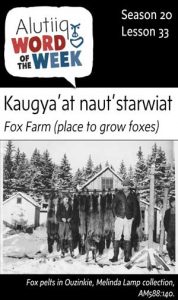 Kaugya’at naut’stagwit.–Fox Farm (place to grow foxes)
Kaugya’at naut’stagwit.–Fox Farm (place to grow foxes)
Kaugya’at naut’starwiat et’llria Long Island-mi.–There used to be a fox farm on Long Island.
Fur farming was once one of Alaska’s largest industries. For nearly two centuries, Alaskans raised a variety of small furbearers fox, chinchilla, rabbit, mink, muskrat, and beaver. The industry worked to improve the quality of pelts available for sale, enhance the range in which animals could be harvested, and stabilize dwindling supplies of fur in over trapped areas.
Causal fur farming began in Russian times when people released foxes on coastal islands. The animals weren’t tended. They simply multiplied naturally and people returned to harvest them. Eventually, caretakers began feeding island fox populations and their operations evolved into carefully controlled farms with pens, nutritional supplements, and veterinary care. Managed farms had greater start-up costs, but they reduced poaching, dramatically improved the survival of fox pups, and permitted selective breeding to create quality pelts.
In the early decades of the 1900s, fox farming became popular in the Kodiak region. Many entrepreneurs, including Alutiiq families, established fur ranching operations. The first formal enterprise was the Kodiak Fox Farm on Long Island, a facility with breeding pens and corals. The initial breeding stock for the farm came from Chirikof Island, where foxes from the Semidi Islands were released in 1891.[xyz-ihs snippet=”Adsense-responsive”]Additional fox farms sprang up on many local islands. The impressive list of fox farm locations include Amook Island, Bare Island, Raspberry Island, Whale Island, Abrams Island, Hog Island, Marmot Island, Dry Island, Nelsons Island, Low Island, Kalsin Island, Ugak Island, and others.
To start their farms, ranchers purchased animals from other Alaskan fur farmers or from Alutiiq hunters, who captured and sold live foxes. Live trapping was a lucrative business. A pair of healthy fox pups could be worth as much as $600 (over $7,500 in today’s dollars). Native people also sold dried fish for fox feed, which operators supplemented with fresh wild foods like fish, bird eggs, and berries.
Source: Alutiiq Museum
